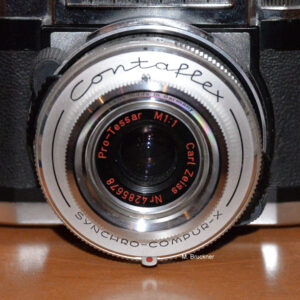Lenses
The best camera in the world is just a black box without an optical construction that brings the light of the image to be recorded to the „storage medium“, i.e. film or CCD chip, in a pre-calculated way. The lens takes care of that. Whether that’s done with a fixed focal length or a megazoom, a good lens excels
– Directory freedom (no pillows or bumps)
– color fidelity
– Low sensitivity to scattered light
– High luminous intensity
– Mechanical robustness
I would like to present what I consider to be the best, most beautiful or even most spectacular lenses here.

Canon AC 75-200 f:4.5 for Canon T 80
Type: AF sliding zoom with Canon FD connection bayonet
11 lenses in 8 groups
Angle of view: 27° – 10°
Weight: 590 grams
Filter diameter: 58mm
greatest length: 185mm
smallest distance (normal)1.8m
smallest distance (macro) 55cm
3 operating modes: „one shot“, „servo“ and „manual“
Focal length scale on the lens barrel
Distance scale
Built-in auto focus motor

Zeiss Olympia Sonnar 1:4/250 for Zeiss Ikon Contarex
Year of manufacture: 1963-1973
Lenses/Groups: 4/4
Angle of view: 10°
Filter connection: S67
aperture transmission
Fast focus device, locking knob
Weight: 1100g
Close-up limit: 2.5m
Handle/Tripod thread
Sun visor can be screwed on.
A wonderful telephoto lens, use of a tripod is recommended!

Mamiya Sekor C 1:4/24mm fisheye for M645 A special lens where hardly a line stays straight.
Angle of view: 180°
smallest aperture: 22
Lenses/Groups: 10/8
shortest distance: 0.3m
built-in filters: yellow, orange, red and skylight
Overall length: 82mm
diameter: 100mm
weight: 785g
Even tight spaces can be seen at a glance. Always pay attention to the feet that like to be in the picture. Unfortunately, there are few opportunities to use a fisheye lens sensibly in everyday photography.

Zeiss Sonnar 1:4 135mm telephoto lens for the Zeiss Ikon Contax viewfinder cameras.
Like all Zeiss lenses, a masterpiece of precision and optical quality. With all viewfinder cameras without etched focal length ranges in the viewfinder, the use of the 135 Sonnar requires an additional viewfinder that is attached to the camera. Unlike the Kodak Retina, at least the distance setting is fully coupled and visible in the viewfinder window.

The Sigma 1:4.5-5.6 120-400 DG HSM for Nikon F is still a relatively compact telephoto zoom lens with a focal length that goes beyond the usual 300mm. The lens can be used on my small Nikon D3100 (DX format) as well as on the Nikon D610 (FX format). In the DX format, the focal length must be calculated 1.5 times, which corresponds to 180-600mm.
With a weight of almost 2kg (with tripod collar), the Sigma Zoom is almost at my pain limit, the small pack size of 20cm in length is positive. The lens construction is quite complex according to the weight: 21 lenses in 15 groups. Due to the internal focusing with the ultrasonic motor, filters of all kinds can be used without any problems. The two-stage image stabilizer allows exposure times of up to 1/60 second.


Zeiss Pro-Tessar M 1:1 macro lens. The attachment consists of three lenses in two sections and, with the remaining three lenses of the Tessar lens built into the Contaflex, results in a focal length of 30.2 mm with a maximum aperture of 1:5. The shooting distance is 10 cm at infinity.
The scale of 1:1 is also achieved here. When set to 0.7 m, a slight enlargement is achieved at a shooting distance of approx. 7 cm. (1.15:1) Zeiss Ikon specifies a minimum aperture of 1:8 in order to achieve the best possible imaging performance. A four-fold extension factor must be taken into account. (Not applicable to the Contaflex Super BC which has a TTL measurement.)

A universal lightweight zoom lens is the 35-105 for all Canon SLR cameras with FD connection. Introduced in 1981, having this lens on your camera is a good choice.
The length of the lens does not change when focusing or zooming. With its 600 grams, it doesn’t weigh too much, but it is solidly constructed to master the rough everyday life without any problems. The continuous initial aperture of 3.5 is sufficient to be able to take pictures without any worries even in unfavorable light conditions (and the corresponding film). The switchable macro function also opens up the close-up range of up to approx. 20 cm.

Note: Of course there are cameras that do not have a construction made of glass lenses: The pinhole cameras.
In this special case, the light is bundled through an extremely small hole and projected onto the medium to be exposed. The effect is a continuous depth of field and, due to the long exposure times, unusual effects on moving surfaces. (Sea, cloudy sky, etc.)
The Zero Image Pinhole is made entirely of teak and works with an aperture of 1:138 and a focal length of approx. 38 mm using 35mm film
Continue with manuals or start page
